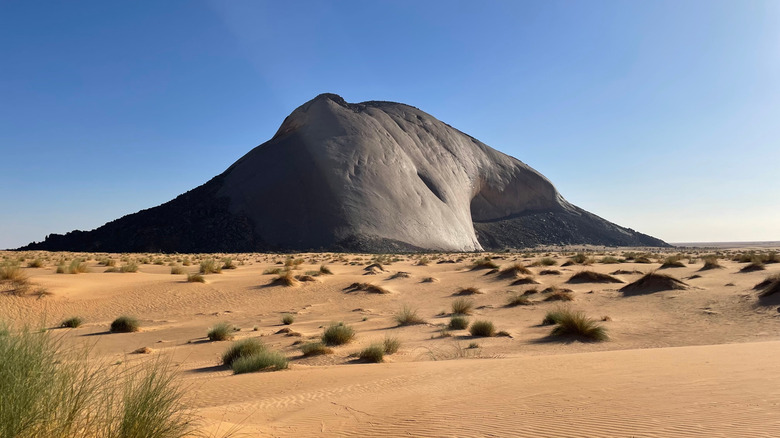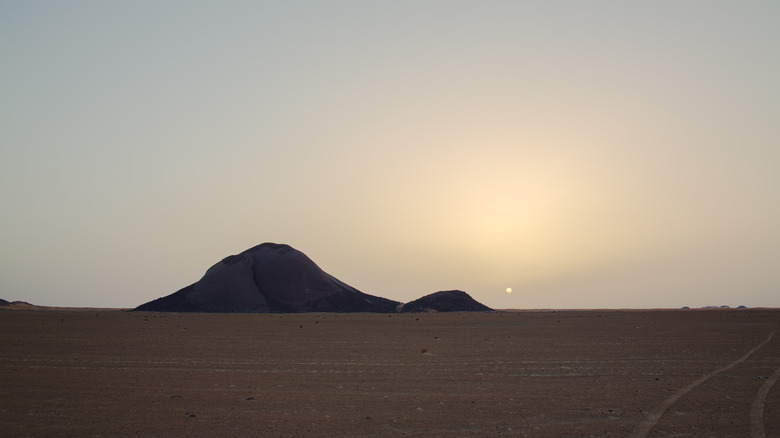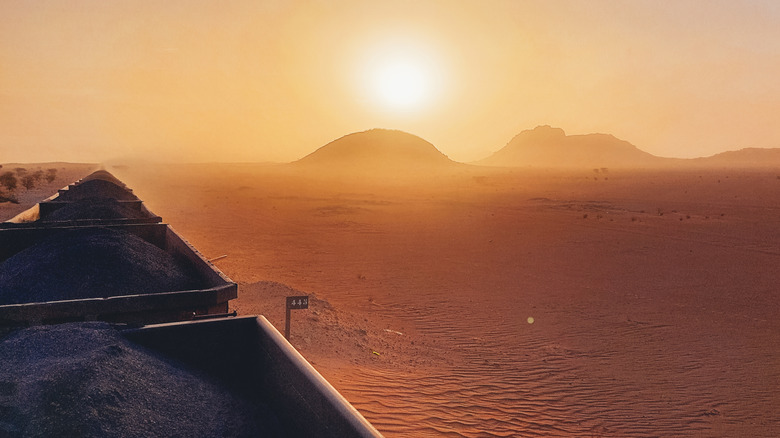One Of The World's Largest Natural Monoliths Is A Secret Stone Wonder In Africa Few Tourists Can Find
The continent of Africa is massive, but nearly a third of its land area is taken up by the arid Sahara Desert. Many North African countries, like Tunisia, the underrated desert escape with remarkable sand dunes, are dominated by hundreds of miles of barren, golden expanse. But the Sahara isn't just ceaseless sand dunes. If you dare to venture into its dry and sometimes disorienting territory, you might come across, say, one of the world's largest natural arches, ascending from the remote desert of Chad. On the western side of North Africa, Mauritania's portion of the Sahara holds another natural wonder only reachable by unmarked routes through endless desert: the Ben Amera monolith.
The largest monolith in Africa (and frequently considered the second largest in the world), Ben Amera is the crescendo of a series of monoliths grouped together here in the desert. It stands over 2,000 feet tall, though there's speculation that it could be significantly taller, since part of it is buried under sand. Not many travelers make their way to Ben Amera, since it lacks any roads to get to, and the nearest town, Choum, is just shy of 40 miles away. Still, it's not impossible to find, and there are tour services that take away the uncertainty of having to locate the secret stone yourself. Just prepare for a more wild journey through the desert to this humbling giant that's drawn people since ancient civilization.
The untamed, impressive beauty of Ben Amera
Even from a distance — you can see the colossal monolith from Mauritania's long iron ore train — Ben Amera is imposing. It's not just the sheer size that makes it unique, though. What classifies it as a monolith is that it's composed of a single block of hard stone that's evaded erosion over millions of years. In the case of Ben Amera, the hard rock is a type of granite, which has stood here in spite of the ever-changing desert landscape since the dawn of humanity. In fact, there are prehistoric petroglyphs around the area of Ben Amera, and some believe the monolith may have even had a ceremonial purpose for ancient people.
One folk tale about the monolith connects it to another monolith nearby, Ben Aicha. In the tale, Ben Amera and Ben Aicha were once married and stood close together. After Ben Aicha's betrayal, the two monoliths moved apart, separated by smaller monoliths between them that represent their children. In 1999, Ben Aicha became an open-air gallery when a group of artists from around the world, led by sculptor Siriki Ky, created a unique collection of sculptures right in the Sahara. These works of art, related to the theme of peace, can be found dotted around Ben Aicha and are also a must-see in the area.
The long journey through the desert to Ben Amera
No matter what route you take, getting to Ben Amera is a trek that requires some off-roading and potentially a bit of hiking. There are a couple of options for places to start from in Mauritania, though. The closest city you can fly into is Atar. The Atar International Airport only has arrivals from Nouakchott, Mauritania, but from here you can connect from a few different North African and European cities, including Paris. You can make Ben Amera a day trip from Atar by booking a guided tour (there are many local guides offering trips to Ben Amera). The guide will drive you in a 4x4 across the desert for an outing that takes roughly three hours to Ben Amera.
Another option (for the most adventurous travelers) is to take a train ride from Nouadhibou, on Mauritania's coast, to Choum, then hire a guide to drive you to Ben Amera from there. The train ride is by means of the Mauritanian iron ore train, one of the longest trains in the world. It's also long in terms of duration — expect about a 10-hour ride to Choum. If you do opt for the train ride, read up on a simple tip for traveling on long-haul train rides.
Once at the site of Ben Amera, you might notice an encampment set up by some guides. It's legal to camp overnight at the monolith, and some people use the base camp for climbing the monolith. It's a difficult climb, but for experienced climbers, you can do so by booking through a local agency to get permits and access to climbing routes.


